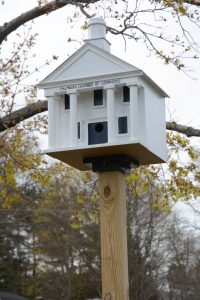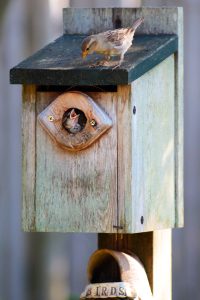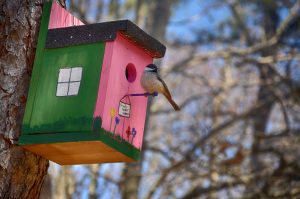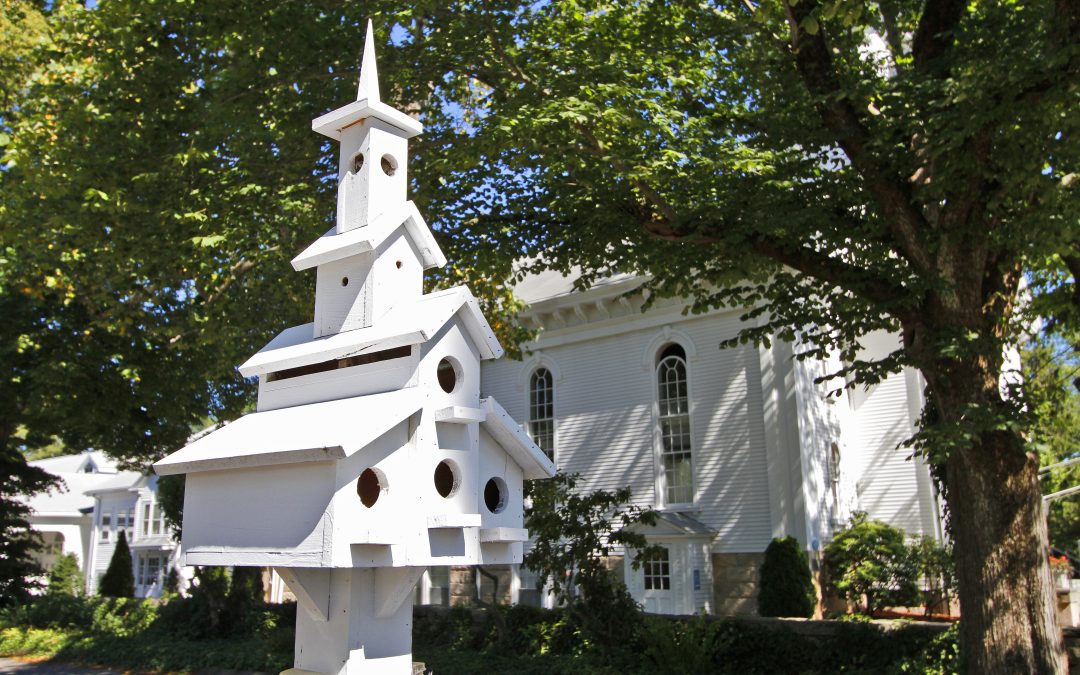By LAURA GROSS-HIGGINS
Attracting birds to your backyard has many elements. One of them is figuring out what type of birds you want, what they need for habitat in the way of food and shelter and also whether you want to provide a birdhouse, or nest box, they can use to raise their young.
If you are serious about providing a nest space for wild birds, then the webpage from the Cornell Lab of Ornithology outlines the basic needs its researchers recommend for a nest box:
Recommended bird house features

Brid houses at the Teaticket School.
Untreated [not painted] wood (pine, cedar or fir)
An extended sloped roof
Rough or grooved interior walls
Recessed floor
Drainage holes
Ventilation holes
Easy access for you to monitor and clean the box
Sturdy construction
No outside perches
They recommend knowing what species are in your area and buying a box that suits their needs. So a bluebird box might not work in the average yard—they like to live near the edges of fields and generally are hole dwellers.
Cornell also suggests that homeowners monitor their boxes regularly because birdhouses can easily become a home to house sparrows or European starlings, species that compete with native birds for nest boxes.

American Tree Sparrow baby waits for some food from it mother.
Another website, www.drsfostersmith.com, gives tips on selecting a nest box in a store. Its page says to pay attention to entrance hole size. Equally important is the distance from the hole to the floor (too deep and the nestlings and parent might find it hard to leave, too shallow and a meal of baby birds is there for the taking), the overall floor size, hole diameter, the placement of the box above the ground and so on.
A third site, Birdwatching-Bliss.com, gives extensive measurements for all of these categories. I learned for instance that a 4-by-4 inch floor size and depth to floor from hole of 6 to 8 inches would accommodate chickadees and tits as well as wrens. If you are thinking of building your own, that site gives all the pertinent measurements.
Before I did my research, I had known about the issue with perches. A friend had given us a birdhouse and when it fell apart, I went to For Birds Only, on East Main Street in Falmouth. I bought one and even made a hole for a dowel as a perch. When I asked the former owner, Leigh Volkmann, about the lack of a perch, she explained to me that perches give predators something to perch on, too, and that the birds really don’t need them. That cute little squirrel that eats your birdseed will not think twice about eating a baby bird.
For Birds Only changed hands this January. Karen L. Cannata-Smith is now the owner. The store has a variety of wooden houses, both utilitarian and decorative, some simple and some elaborate. It even has a gourd-shaped birdhouse (the line is called Gord-O) and roosting pouches.
If you want to build a house and don’t know where to start, there are also books on the subject and you can find designs online. On-Cape, Robert M. MacLeod of Teaticket gave a Make Your Own Birdhouse workshop at Mahoney’s Garden Center in East Falmouth in 2011. I talked to him about how he got started. He said he used to work in construction, then retired in 2002. He wanted something to do in his retirement. A woodworker, too, he settled on birdhouses about six or seven years ago and uses scrap or recycled wood. Mr. MacLeod’s wooden birdhouses are sold at Mahoney’s; at Waquoit Feed & Garden Store, just down Route 28 from Mahoney’s; at Eastman’s Hardware in Falmouth; and on the Lower Cape. Mahoney’s also has the woven roosting pouches. They are not for nests, but provide some shelter for birds.
Another place that sells nest boxes is Scenic Roots Garden Center on Route 6A in Sandwich. I spoke with co-owner Donna Kutil. She said Scenic Roots has a very small inventory. Scenic Roots sells bluebird, chickadee or wren, and also bat houses. They are all wood, mostly pine or cedar. It’s mostly a seasonal thing. She said when the store runs out, that’s when reordering is done. Donna said that landscaping and birding go hand in hand: you can plant and plan your yard to meet food, shelter and habitat needs for birds.
Aubuchon Hardware in Pocasset also has a limited number of birdhouses, a few of which are wood.
 I did ask Mary A. Richmond, who writes the Enterprise’s Weekly Nature Watch, if she had a birdhouse in her yard. She said she did not because she did not want to encourage any starlings or European sparrows—not native to the Cape—to establish a territory in her yard. She recommended that I talk to Mike O’Connor in Orleans, which I did.
I did ask Mary A. Richmond, who writes the Enterprise’s Weekly Nature Watch, if she had a birdhouse in her yard. She said she did not because she did not want to encourage any starlings or European sparrows—not native to the Cape—to establish a territory in her yard. She recommended that I talk to Mike O’Connor in Orleans, which I did.
Mike O’Connor works at the Bird Watcher’s General Store in Orleans on Route 6A. He said that many people buy birdhouses, not for the birds but for the decorative punch they give to a yard. If that is your intention, then feel free to buy one of the fancier models. But those models, as pretty as they are, may not attract nesting birds.
He said customers can buy a utilitarian birdhouse without having any idea of what type of bird it will be good for. And then they wonder why the birds don’t use them. Mr. O’Connor said that often people will buy a birdhouse that may not have the right drainage or ventilation. He did not recommend plastic birdhouses. Plastic birdhouses or those with metal roofs (ones that don’t have wood under the copper) can be bad for the nestlings. The metal roofs can overheat the baby birds inside. He said the plastic ones give off a weird smell that he can’t stand and could not imagine the birds could stand it, too.
It’s important to be able to clean the houses, too. Pests can linger in old nests. So being able to access them to clean them out is an important feature. Some don’t seem to have been designed to be easily cleaned and maintained.
Mr. O’Connor said he buys handmade birdhouses from a man in Springfield who makes them out of recycled stockade fences and from another Cape resident, too. He said that gourd nests are great for martins. Many they sell are actually artificial gourds, which have a twist-off cover for cleaning. He said that Mary Kelleher of Mashpee, a member of the Cape Cod Bird Club, has helped bring swifts back to the Cape through the use of these gourd nest boxes.
Bird houses are used by more than your average property owners, too. The 300 Committee, Falmouth’s land trust, has used a number of boxes on its properties. I got an e-mail from Jack Sidar of the organization. He told me they had 10 kestrel boxes built and installed by AmeriCorps Cape Cod and an Eagle Scout. They also have 15 wood duck boxes that were recently made by the Falmouth Rod & Gun Club in East Falmouth. He said he thought there were about 20 bluebird boxes built and installed by 300 Committee volunteers and the rod and gun club members. As for bat boxes (mammals, really, but they fly), they bought three and they were installed by 300 Committee volunteers.
And at Ashumet Holly Reservation in East Falmouth, the Mass Audubon staff have installed a lot of simple wooden birdhouses out in the field. The tree swallows seem to like these a lot.
Birdhouses are fun to own and watching them can provide insight into the lives of birds. Some are funny.
To me, it seems you hardly need birdhouses for house wrens and Carolina wrens. Last fall, I was cleaning out our greenhouse and found two old wren nests in some unused long flower boxes there. They were under the bench trays. I threw them away.
The irony is that these wrens have used our greenhouse as their “spring grocery store” for several springs, often stymieing my husband’s efforts at growing seedlings. The plants would be growing just fine one day; then he would come out the next, and all of the seedlings had their early leaves snipped off! We have tried hardware cloth and other things to discourage them. What I hadn’t realized until I found those nests was that they had been nesting inside the greenhouse.
Just this week, I saw the wrens going in and out of our overturned canoe at the side of our driveway. It seems the upside-down seat is a perfect place for a nest and out of sight of predators. Wrens are one species that seems to be creative in its nesting habits.
So, if you are planning to buy a birdhouse, it helps to decide first what you want it for and what species you hope to house. There are plenty of birdhouses available. I am not discouraging decorative ones, just making you aware that there are other factors that are more important if you want birds to nest in your yard.

